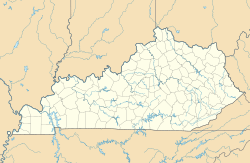Ringos Mill Covered Bridge facts for kids
Quick facts for kids |
|
|
Ringos Mill Covered Bridge
|
|

Ringos Mill Covered Bridge
|
|
| Location | 13.7 miles south of Flemingsburg, Kentucky on Ky 158 |
|---|---|
| Built | 1867 |
| Architectural style | Burr truss |
| NRHP reference No. | 76000880 |
| Added to NRHP | March 26, 1976 |
The Ringos Mill Covered Bridge is a historic bridge in Fleming County, Kentucky. It crosses Fox Creek with a single span that is 90 feet long. The bridge got its name from a grist mill (a mill that grinds grain) that used to be located just 50 yards downstream.
Building the Ringos Mill Bridge
This bridge was built in 1867. Its main timbers, which are the large wooden beams, are made from yellow pine. It's thought that the same builder who constructed the Hillsboro Covered Bridge, located a few miles down Fox Creek, also built this one.
The base structures that support the bridge, called abutments, are made of red stone. These stones are covered with a layer of concrete. The bridge's walls have two sides, and they are made from yellow poplar wood.
Special Design Features
To let in light and fresh air, the bridge has special openings in its siding. These are called clerestory openings. They are placed higher up on the walls, like windows.
The bridge's design is a good example of a "multiple kingpost" truss. This type of design was often linked to a patent by Theodore Burr from 1814, known as the Burr truss.
Is it a True Burr Truss?
For a long time, many people thought the Ringos Mill Covered Bridge used a true Burr truss design. However, experts now believe it might not be a Burr truss.
The special thing about Theodore Burr's design was placing the road between the arches, not on top of them. While the multiple kingpost design is strong, it's not exactly the same as Burr's specific patented improvement.
Some early ideas about classifying these bridges were later found to be not completely accurate. For example, the idea that engineers always got a dollar per foot for using patented designs was mostly true for a different engineer named Ithiel Town, who designed the Town lattice truss.



